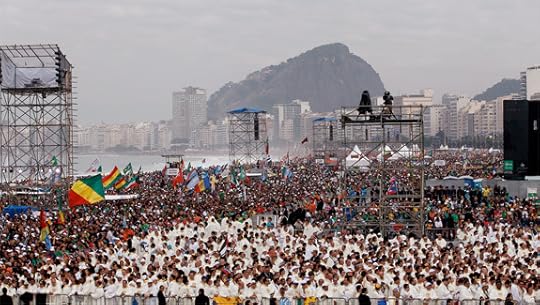The Key Themes of World Youth Day 2013

The Key Themes of World Youth Day 2013 |
William
L. Patenaude | CWR
The
words and actions of Pope Francis in Brazil built directly on the
evangelizing work of his predecessors
Two
valuable lessons came out of World Youth Day 2013. The first is that
the Holy Spirit is intent on igniting with joy and resilience the
post-conciliar Church of the twenty-first century. The second is
that, in large part due to the catechetical influences of Bl. John
Paul II and Benedict XVI, Pope Francis’s flock can better balance
the joys of the Spirit with the Cross of Christ.
It
will be helpful, then, to ponder some themes from Rio’s World Youth
Day because it is highly likely we’ll be encountering them
repeatedly as an energized Pope Francis shepherds his flock deeper
into the twenty-first century.
Go
and Make Disciples
“Where
does Jesus send us? There are no borders, no limits: he sends us to
everyone. The Gospel is for everyone, not just for some. It is not
only for those who seem closer to us, more receptive, more welcoming.
It is for everyone. Do not be afraid to go and to bring Christ into
every area of life, to the fringes of society, even to those who seem
farthest away, most indifferent. The Lord seeks all, he wants
everyone to feel the warmth of his mercy and his love.” — Pope
Francis’s closing homily,
World Youth Day, 2013.
Popes,
bishops, and even laity have said and written much during these past
few years on the New Evangelization. When planning for World Youth
Day 2013 began during the pontificate of Pope Benedict XVI the time
had come to urge the Church to act. Thus the theme “Go and make
disciples” seemed fitting for an event that draws millions of young
people and many millions more (of every age) through social media.
But
then Benedict XVI’s doctors told him that he could no longer travel
by air. And it seemed likely that even if he could he might not have
the strength that World Youth Day schedules demand. (One wonders how
much his being unable to travel to Rio de Janeiro influenced his
decision to cede the Chair of St. Peter.)
The
question of whether the pope would attend World Youth Day vanished
with the papal transition. Pope Francis brought to the world stage a
bold and gregarious personality. He changed the rules of papal
engagement and accelerated the use of social media. He continues to
bring his own style to the papacy, one that resonates in a world of
political uncertainty, economic struggle, and a growing weariness
with impersonal spirituality.
With
a stronger, younger body than his predecessor’s, Pope Francis began
charging into crowds—which, come to think of it, seems natural to
do for those who espouse an incarnational faith. Once inside the
crowds, whether in Rome or Rio or wherever, he is especially happy
when he meets those on the outskirts.
We
see the fruits of this charging
in and greeting the outskirts by
listening to those who are not at all enamored with Catholicism but
are attracted to Pope Francis.
Carl E. Olson's Blog
- Carl E. Olson's profile
- 20 followers



